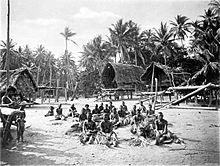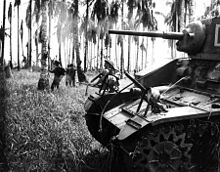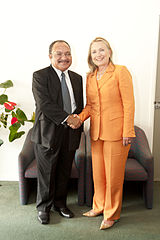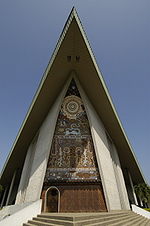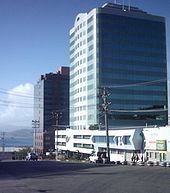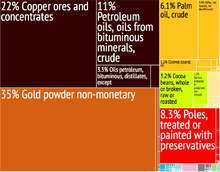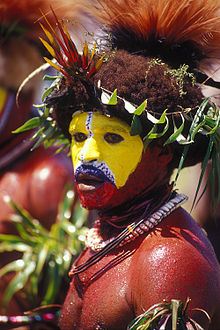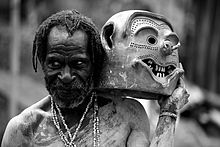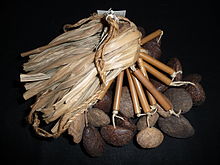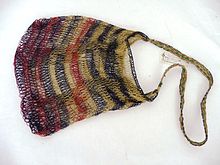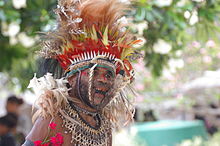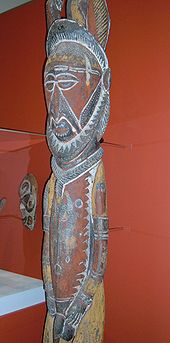
Papua New Guinea
Background Information
SOS Children produced this website for schools as well as this video website about Africa. SOS Children is the world's largest charity giving orphaned and abandoned children the chance of family life.
| Independent State of Papua New Guinea Independen Stet bilong Papua Niugini
|
||||||
|---|---|---|---|---|---|---|
|
||||||
| Motto: " Unity in diversity" | ||||||
| Anthem: O Arise, All You Sons | ||||||
|
|
||||||
| Capital and largest city |
Port Moresby 9°30′S 147°07′E |
|||||
| Official languages |
|
|||||
| Demonym | Papua New Guinean | |||||
| Government | Unitary parliamentary democracy under constitutional monarchy | |||||
| - | Monarch | Elizabeth II | ||||
| - | Governor General | Michael Ogio | ||||
| - | Prime Minister | Peter O'Neill | ||||
| Legislature | National Parliament | |||||
| Independence | ||||||
| - | from Australia | 16 September 1975 | ||||
| Area | ||||||
| - | Total | 462,840 km2 ( 56th) 178,703 sq mi |
||||
| - | Water (%) | 2 | ||||
| Population | ||||||
| - | 2012 estimate | 6,310,129 ( 105th) | ||||
| - | 2000 census | 5,190,783 | ||||
| - | Density | 15/km2 ( 201st) 34.62/sq mi |
||||
| GDP ( PPP) | 2011 estimate | |||||
| - | Total | $16.863 billion | ||||
| - | Per capita | $2,532 | ||||
| GDP (nominal) | 2011 estimate | |||||
| - | Total | $12.655 billion | ||||
| - | Per capita | $1,900 | ||||
| Gini (1996) | 50.9 high |
|||||
| HDI (2011) | low · 153th |
|||||
| Currency | Papua New Guinean kina ( PGK) |
|||||
| Time zone | AEST ( UTC+10) | |||||
| - | Summer ( DST) | not observed ( UTC+10) | ||||
| (as of 2005) | ||||||
| Drives on the | left | |||||
| Calling code | +675 | |||||
| ISO 3166 code | PG | |||||
| Internet TLD | .pg | |||||
Papua New Guinea (PNG; Tok Pisin: Papua Niugini), officially named the Independent State of Papua New Guinea, is a country in Oceania that occupies the eastern half of the island of New Guinea (the western portion of the island is a part of the Indonesian provinces of Papua and West Papua) and numerous offshore islands. It is located in the southwestern Pacific Ocean, in a region described since the early 19th century as Melanesia. The capital is Port Moresby.
Papua New Guinea is one of the most culturally diverse countries in the world. According to recent data, 841 different languages are listed for the country, although 11 of these have no known living speakers. There may be at least as many traditional societies, out of a population of about 6.3 million. It is also one of the most rural, as only 18 percent of its people live in urban centres. The country is one of the world's least explored, culturally and geographically, and many undiscovered species of plants and animals are thought to exist in the interior of Papua New Guinea.
Strong growth in Papua New Guinea's mining and resource sector has led to PNG becoming the sixth fastest-growing economy in the world as of 2011. Despite this, many people live in extreme poverty, with about one-third of the population living on less than US$1.25 per day. The majority of the population still live in traditional societies and practice subsistence-based agriculture. These societies and clans have some explicit acknowledgement within the nation's constitutional framework. The PNG Constitution expresses the wish for "traditional villages and communities to remain as viable units of Papua New Guinean society", and for active steps to be taken in their preservation.
After being ruled by three external powers since 1884, Papua New Guinea gained its independence from Australia in 1975. It became a separate Commonwealth realm with Her Majesty Queen Elizabeth II reigning as the Queen of Papua New Guinea.
History
Human remains have been found which have been dated to about 50,000 BC although this is an estimate. These ancient inhabitants probably migrated from Southeast Asia, from people whose ancestors had originated in Africa 50,000 to 70,000 years ago. New Guinea was first populated by modern humans at approximately the same time as Australia.
Agriculture was independently developed in the New Guinea highlands around 7000 BC, making it one of the few areas in the world where people independently domesticated plants. A major migration of Austronesian speaking peoples came to coastal regions roughly 500 BC. This has been correlated with the introduction of pottery, pigs, and certain fishing techniques. More recently, in the 18th century, the sweet potato was taken to New Guinea, having been introduced to the Moluccas by Portuguese traders. The far higher crop yields from sweet potato gardens radically transformed traditional agriculture; sweet potato largely supplanted the previous staple, taro, and gave rise to a significant increase in population in the highlands.
Although headhunting and cannibalism have been practically eradicated, in the past they occurred in many parts of the country as part of ritual practices. For example, in 1901, on Goaribari Island in the Gulf of Papua, a missionary, Harry Dauncey, found 10,000 skulls in the island's Long Houses. According to the writer Marianna Torgovnick, "The most fully documented instances of cannibalism as a social institution come from New Guinea, where head-hunting and ritual cannibalism survived, in certain isolated areas, into the fifties, sixties, and seventies, and still leave traces within certain social groups."
Little was known in Europe about the island until the 19th century, although Portuguese and Spanish explorers, such as Dom Jorge de Meneses and Yñigo Ortiz de Retez, respectively, had encountered it as early as the 16th century. Traders from Southeast Asia had visited New Guinea beginning 5,000 years ago to collect bird of paradise plumes. The country's dual name results from its complex administrative history before independence. The word papua is derived from an old local term of uncertain origin, and "New Guinea" (Nueva Guinea) was the name coined by the Spanish explorer Yñigo Ortiz de Retez. In 1545, he noted the resemblance of the people to those he had earlier seen along the Guinea coast of Africa. The northern half of the country was ruled as a colony for some decades by Germany, beginning in 1884, as German New Guinea. The southern half was colonised in the same year by the United Kingdom as British New Guinea, but in 1904 with the passage of the Papua Act, 1905 was transferred to the newly formed Commonwealth of Australia who took on its administration. Additionally from 1905, British New Guinea was renamed the Territory of Papua.
During World War I, German New Guinea was occupied by Australia and after the war was given a League of Nations Mandate to administer it. Papua, by contrast, was deemed to be an External Territory of the Australian Commonwealth, though as a matter of law it remained a British possession. This was significant for the country's post-independence legal system. The difference in legal status meant that up until 1949, Papua and New Guinea had entirely separate administrations, both controlled by Australia.
The New Guinea campaign (1942–1945) was one of the major military campaigns of World War II. Approximately 216,000 Japanese, Australian and U.S. soldiers, sailors and airmen died during the New Guinea Campaign. The two territories were combined into the Territory of Papua and New Guinea after World War II, which later was simply referred to as "Papua New Guinea".
However, certain statutes continued to have application only in one of the two territories. This territorial difference of law was complicated further by the adjustment of the former boundary among contiguous provinces with respect to road access and language groups. Some of such statutes apply on one side only of a boundary which no longer exists.
The administration of Papua became open to United Nations oversight; a peaceful independence from Australia occurred on 16 September 1975, and close ties remain (Australia continues as the largest bilateral aid donor to Papua New Guinea). Papua New Guinea was admitted to membership in the United Nations on 10 October 1975.
A secessionist revolt in 1975–76 on Bougainville Island resulted in an eleventh-hour modification of the draft Constitution of Papua New Guinea to allow for Bougainville and the other eighteen districts to have quasi-federal status as provinces. A renewed uprising started in 1988 and claimed 20,000 lives until it was resolved in 1997. Following the revolt, the autonomous Bougainville elected Joseph Kabui as president. He was succeeded by his deputy John Tabinaman, who continued to be re-elected as leader until the election of December 2008, which James Tanis won.
Anti-Chinese rioting, involving tens of thousands of people, broke out in May 2009. The initial spark was a fight between Chinese and Papua New Guinean workers at a nickel factory under construction by a Chinese company. Native resentment against the numerous small businesses being run by Chinese led to the rioting.
Politics
Papua New Guinea is a Commonwealth realm, with Her Majesty Queen Elizabeth II acting as its Sovereign and Head of State. It was expected by the constitutional convention, which prepared the draft constitution, and by Australia, the outgoing metropolitan power, that Papua New Guinea would choose not to retain its link with the Commonwealth monarchy. The founders, however, considered that imperial honours had a cachet that the newly independent state would not be able to confer with a purely indigenous honours system, so the monarchy was retained. The Queen is represented by the Governor-General of Papua New Guinea, currently Michael Ogio. Papua New Guinea and the Solomon Islands are unusual among Commonwealth realms in that Governors-General are selected by the legislature rather than by the executive branch.
Actual executive power lies with the Prime Minister, who heads the cabinet of 31 MPs from the ruling Coalition, which make up the government. The current Prime Minister is Peter O'Neill. The unicameral National Parliament has 111 seats, of which 22 are occupied by the governors of the 21 provinces (2 new ones were approved by Parliament in 2012) and the National Capital District (NCD). Candidates for members of parliament are voted upon when the prime minister asks the Governor-General to call a national election, a maximum of five years after the previous national election.
In the early years of independence, the instability of the party system led to frequent votes of no confidence in Parliament with resulting changes of the government of the day, but with referral to the electorate, through national elections only occurring every five years. In recent years, successive governments have passed legislation preventing such votes sooner than 18 months after a national election and within 12-month of the next election, and in December 2012 the first 2 (of 3) readings were passed to prevent votes of no confidence occurring within the first 30 months. (This restriction on votes of no confidence has arguably resulted in greater stability, although perhaps at a cost of reducing the accountability of the executive branch of government.
Elections in PNG attract large numbers of candidates. After independence in 1975, members were elected by the first past the post system, with winners frequently gaining less than 15% of the vote. Electoral reforms in 2001 introduced the Limited Preferential Vote system (LPV), a version of the Alternative Vote. The 2007 general election was the first to be conducted using LPV.
In foreign policy, Papua New Guinea is a member of the Pacific Islands Forum and the Melanesian Spearhead Group (MSG) of countries and was accorded Observer status within ASEAN in 1976, followed later by Special Observer status in 1981. It is also a member of APEC and an ACP country, associated with the European Union
Since Aug-2011, there was a political crisis between the parliament-elect Prime Minister, Peter O'Neill (voted into office by a large majority of MPs) and Sir Michael Somare, who was deemed by the Supreme Court (in a December Opinion, 3:2) to retain office. The stand-off between Parliament and the Supreme Court continued until the July 2012 National Elections, with legislation passed effectively removing the Chief Justice and subjecting the Supreme Court members to greater control by the Legislature, as well as a series of other laws passed, for example limiting the age for a Prime Minister. The confrontation reached a peak, with the Deputy Prime Minister entering the Supreme Court, during a hearing, escorted by some police, ostensibly to 'arrest' the Chief Justice. There was strong pressure amongst some MPs to defer the National Elections for a further six months-1-year, although their powers to do that were highly questionable. The Parliament-elect 'Prime Minister' and other cooler-headed MPs carried the votes for the writs for the new Election to be issued, slightly late, but for the Election itself to occur on time, thereby avoiding a continuation of the Constitutional Crisis. The crisis was tense at times, but largely restricted to the political and legal fraternity, plus some police factions, but the public and public service (including most police and military) standing back. It was a period when, with increased telecommunication access and use of social media (notably Facebook and mobile phones) the public and students played some part in helping maintain restraint and demanding the leadership to adhere to Constitutional processes and not to defer the Elections and the people's say in who should be their legitimate representatives for the next five years.
Under an Amendment of 2002 the leader of the party winning the largest number of seats in the Election is invited by the Governor-General to form the Government, if he can muster the necessary majority in Parliament. The process of forming such a coalition in PNG, where there is little ideologically binding parties together, involves considerable horsetrading right up until the last moment. Peter O'Neil emerged Papua New Guinea's Prime Minister after the July 2012 Election, and formed a Government with the former Governor of East New Britain Province, Leon Dion as Deputy Prime Minister.
Law
The unicameral Parliament enacts legislation in the same manner as in other jurisdictions that have "cabinet," "responsible government," or "parliamentary democracy": it is introduced by the executive government to the legislature, debated and, if passed, becomes law when it receives royal assent by the Governor-General. Most legislation is actually regulation implemented by the bureaucracy under enabling legislation previously passed by Parliament.
All ordinary statutes enacted by Parliament must be consistent with the Constitution. The courts have jurisdiction to rule on the constitutionality of statutes, both in disputes before them and on a reference where there is no dispute but only an abstract question of law. Unusual among developing countries, the judicial branch of government in Papua New Guinea has remained remarkably independent, and successive executive governments have continued to respect its authority.
The "underlying law" – that is, the common law of Papua New Guinea – consists of principles and rules of common law and equity in England common law as it stood on 16 September 1975 (the date of Independence), and thereafter the decisions of PNG's own courts. The courts are directed by the Constitution and, latterly, the Underlying Law Act, to take note of the "custom" of traditional communities, with a view to determining which customs are common to the whole country and may be declared also to be part of the underlying law. In practice, this has proved extremely difficult and has been largely neglected. Statutes are largely adapted from overseas jurisdictions, primarily Australia and England. Advocacy in the courts follows the adversarial pattern of other common law countries.
This national court system used in towns and cities is supported by a village court system in the more remote areas. The law underpinning the village courts is 'customary law' and these courts are discussed further on the Law of Papua New Guinea page.
Administrative divisions
Papua New Guinea is divided into four regions, which are not the primary administrative divisions but are quite significant in many aspects of government, commercial, sporting and other activities.
The nation has 22 province-level divisions: twenty provinces, the Autonomous Region of Bougainville and the National Capital District. Each province is divided into one or more districts, which in turn are divided into one or more Local Level Government areas.
Provinces are the primary administrative divisions of the country. Provincial governments are branches of the national government – Papua New Guinea is not a federation of provinces. The province-level divisions are as follows:
|
|
In 2009, Parliament approved the creation of two additional provinces: Hela Province, consisting of part of the existing Southern Highlands Province, and Jiwaka Province, formed by dividing Western Highlands Province. Jiwaka and Hela officially became separate provinces on 17 May 2012.
Geography
At 462,840 km2 (178,704 sq mi), Papua New Guinea is the world's fifty-fourth largest country. Including all its islands, it lies between latitudes 0° and 12°S, and longitudes 140° and 160°E.
The country's geography is diverse and, in places, extremely rugged. A spine of mountains, the New Guinea Highlands, runs the length of the island of New Guinea, forming a populous highlands region mostly covered with tropical rainforest, and the long Papuan Peninsula, known as the 'Bird's Tail'. Dense rainforests can be found in the lowland and coastal areas as well as very large wetland areas surrounding the Sepik and Fly rivers. This terrain has made it difficult for the country to develop transportation infrastructure. In some areas, airplanes are the only mode of transport. The highest peak is Mount Wilhelm at 4,509 metres (14,793 ft). Papua New Guinea is surrounded by coral reefs which are under close watch, in the interests of preservation.
The country is situated on the Pacific Ring of Fire, at the point of collision of several tectonic plates. There are a number of active volcanoes, and eruptions are frequent. Earthquakes are relatively common, sometimes accompanied by tsunamis.
The mainland of the country is the eastern half of New Guinea island, where the largest towns are also located, including the capital Port Moresby and Lae; other major islands within Papua New Guinea include New Ireland, New Britain, Manus and Bougainville.
Papua New Guinea is one of the few regions close to the equator that experience snowfall, which occurs in the most elevated parts of the mainland.
Ecology
Papua New Guinea is part of the Australasia ecozone, which also includes Australia, New Zealand, eastern Indonesia, and several Pacific island groups, including the Solomon Islands and Vanuatu.
Geologically, the island of New Guinea is a northern extension of the Indo-Australian tectonic plate, forming part of a single land mass which is Australia-New Guinea (also called Sahul or Meganesia). It is connected to the Australian segment by a shallow continental shelf across the Torres Strait, which in former ages had lain exposed as a land bridge, particularly during ice ages when sea levels were lower than at present.
Consequently, many species of birds and mammals found on New Guinea have close genetic links with corresponding species found in Australia. One notable feature in common for the two landmasses is the existence of several species of marsupial mammals, including some kangaroos and possums, which are not found elsewhere.
Many of the other islands within PNG territory, including New Britain, New Ireland, Bougainville, the Admiralty Islands, the Trobriand Islands, and the Louisiade Archipelago, were never linked to New Guinea by land bridges. As a consequence, they have their own flora and fauna; in particular, they lack many of the land mammals and flightless birds that are common to New Guinea and Australia.
Australia and New Guinea are portions of the ancient supercontinent of Gondwana, which started to break into smaller continents in the Cretaceous era, 65–130 million years ago. Australia finally broke free from Antarctica about 45 million years ago. All the Australasian lands are home to the Antarctic flora, descended from the flora of southern Gondwana, including the coniferous podocarps and Araucaria pines, and the broadleafed southern beech (Nothofagus). These plant families are still present in Papua New Guinea.
As the Indo-Australian Plate (which includes landmasses of India, Australia, and the Indian Ocean floor in between) drifts north, it collides with the Eurasian Plate. The collision of the two plates pushed up the Himalayas, the Indonesian islands, and New Guinea's Central Range. The Central Range is much younger and higher than the mountains of Australia, so high that it is home to rare equatorial glaciers. New Guinea is part of the humid tropics, and many Indomalayan rainforest plants spread across the narrow straits from Asia, mixing together with the old Australian and Antarctic floras.
PNG includes a number of terrestrial ecoregions:
- Admiralty Islands lowland rain forests – forested islands to the north of the mainland, home to a distinct flora.
- Central Range montane rain forests
- Huon Peninsula montane rain forests
- Louisiade Archipelago rain forests
- New Britain-New Ireland lowland rain forests
- New Britain-New Ireland montane rain forests
- New Guinea mangroves
- Northern New Guinea lowland rain and freshwater swamp forests
- Northern New Guinea montane rain forests
- Solomon Islands rain forests (includes Bougainville Island and Buka)
- Southeastern Papuan rain forests
- Southern New Guinea freshwater swamp forests
- Southern New Guinea lowland rain forests
- Trobriand Islands rain forests
- Trans Fly savanna and grasslands
- Central Range sub-alpine grasslands
At current rates of deforestation, more than half of the country's forests could be lost or seriously degraded by 2021, according to a new satellite study of the region. Nearly one-quarter of Papua New Guinea's rainforests were damaged or destroyed between 1972 and 2002.
Economy
Papua New Guinea is richly endowed with natural resources, including mineral and renewable resources, such as forests, marine (including a large portion of the world's major remaining tuna stocks), and in some parts for agriculture. The rugged terrain, including high mountain ranges and valleys, swamps and islands, and high cost of developing infrastructure, combined with other factors, including serious law and order problems in some centres, and the system of customary land title makes it difficult for outside developers, whilst local developers are also handicapped by years of deficient investment in education, health, ICT and access to finance. Agriculture, both for subsistence and cash crops provides a livelihood for 85% of the population and continues to provide some 30% of GDP. Mineral deposits, including gold, oil, and copper, account for 72% of export earnings. Oil palm production has grown steadily over recent years (largely from estates, but with extensive outgrower output), with palm oil now the main agricultural export, but in terms of households participating coffee remains the major export crop (produced largely in the Highlands provinces), followed by cocoa and coconut oil/ copra from the coastal areas, each largely produced by smallholders and tea, produced on estates and rubber.
Former Prime Minister Sir Mekere Morauta tried to restore integrity to state institutions, stabilize the kina, restore stability to the national budget, privatize public enterprises where appropriate, and ensure ongoing peace on Bougainville following the 1997 agreement which ended Bougainville's secessionist unrest. The Morauta government had considerable success in attracting international support, specifically gaining the backing of the IMF and the World Bank in securing development assistance loans. Significant challenges face the current Prime Minister Sir Michael Somare, including gaining further investor confidence, continuing efforts to privatize government assets, and maintaining the support of members of Parliament.
In March 2006 the United Nations Development Programme Policy called for Papua New Guinea's designation of developing country to be downgraded to least-developed country because of protracted economic and social stagnation. However, an evaluation by the International Monetary Fund in late 2008 found that "a combination of prudent fiscal and monetary policies, and high global prices for mineral commodity exports, have underpinned Papua New Guinea's recent buoyant economic growth and macroeconomic stability. By 2012 PNG had enjoyed a decade of positive economic growth, at over 6% since 2007, even during the Global Financial Crisis years of 2008/9. PNG's Real GDP growth rate as at 2011 was 8.9%., and 9.2% for 2012, according to the Asian Development Bank. This economic growth has been primarily attributed to strong commodity prices, particularly mineral but also agricultural, with the high demand for the mineral products largely sustained even during the crisis from the buoyant Asian markets a booming mining sector, and particularly since 2009 by buoyant outlooks and the actual construction phase for the PNG LNG project, by a consortium led by Exxon and scheduled to commence production in late 2014, for export largely to China and the East Asian market Liquefied Natural Gas; Further gas and mineral projects are proposed (including the large Wafi-Golpu copper-gold mine), with extensive exporation ongoing across the country. Economic 'development' based on the extractive industries also carries difficult consequences for local communities, and there has been much contention around river tailings in the vast Fly river, submarine tailings from the new Ramu-Nickel-cobalt mine, commencing exports in late 2012 (after a delay from landowner-led court challenges), and from proposed submarine mining in the Bismarck Sea (by Nautilus Minerals). One major project conducted through the PNG Department for Community Development suggested that other pathways to sustainable development should be considered.
The PNG Government's long term Vision 2050 and shorter term policy documents, including the 2013 Budget emphasise the need for a more diverse economy, based upon sustainable industries and avoiding the effects of Dutch Disease from major resource extraction projects undermining other industries, as has occurred in many countries experiencing oil or other mineral booms, notably in Western Africa, undermining much of their agriculture sector, manufacturing and tourism, and with them broad-based employment prospects. Various measures have been taken to mitigate these effects, including through the establishment of a sovereign wealth fund, partly to stabilise revenue and expenditure flows, but much will depend upon the readiness to make real reforms to effective utilisation of revenue, tackling rampant corruption and empowering households and businesses to access markets, services and develop a more buoyant economy, with lower costs, especially for small-medium enterprises.
Land tenure
The PNG legislature has enacted various laws in which a type of tenure called " customary land title" is recognised, meaning that the traditional lands of the indigenous peoples have some legal basis to inalienable tenure. This customary land notionally covers most of the usable land in the country (some 97% of total land area); alienated land is either held privately under State Lease or is government land. Freehold Title (also known as fee simple) can only be held by Papua New Guinea citizens.
Only some 3% of the land of Papua New Guinea is in private hands; it is privately held under 99-year state lease, or it is held by the State. There is virtually no freehold title; the few existing freeholds are automatically converted to state lease when they are transferred between vendor and purchaser. Unalienated land is owned under customary title by traditional landowners. The precise nature of the seisin varies from one culture to another. Many writers portray land as in the communal ownership of traditional clans; however, closer studies usually show that the smallest portions of land whose ownership cannot be further divided are held by the individual heads of extended families and their descendants, or their descendants alone if they have recently died.
This is a matter of vital importance because a problem of economic development is identifying the membership of customary landowning groups and the owners. Disputes between mining and forestry companies and landowner groups often devolve on the issue of whether the companies entered into contractual relations for the use of land with the true owners. Customary property – usually land – cannot be devised by will; it can only be inherited according to the custom of the deceased's people. The Lands Act was amended in 2010 along with the Land Group Incorporation Act, intended to improve the management of State land, mechanisms for dispute resolution over land, and to enable customary landowners to be better able to access finance and possible partnerships over portions of their land, if they seek to develop it for urban or rural economic activities. The Land Group Incorporation Act requires more specific identification of the customary landowners than hitherto and their more specific authorisation before any land arrangements are determined; (a major issue in recent years has been an land grab, using, or rather misusing, the Lease-Leaseback provision under the Land Act, notably using 'Special Agricultural and Business Leases' – SABLs – to acquire vast tracts of customary land, purportedly for agricultural projects, but in an almost all cases as a back-door mechanism for securing tropical forest resources for logging, and circumventing the more exacting requirements of the Forest Act, for securing Timber Permits (which must comply with sustainability requirements and be competitively secured, and with the customary landowners approval). Following a national outcry, these SABLs have been subject to a Commission of Inquiry, established in mid-2011, for which the report is still awaited for initial presentation to the Prime Minister and Parliament.
Demographics
Papua New Guinea is one of the most heterogeneous nations in the world. There are hundreds of ethnic groups indigenous to Papua New Guinea, the majority being from the group known as Papuans, whose ancestors arrived in the New Guinea region tens of thousands of years ago. Many remote Papuan tribes still have only marginal contact with the outside world.
The others are Austronesians, their ancestors having arrived in the region less than four thousand years ago. There are also numerous people from other parts of the world now resident, including Chinese, Europeans, Australians, Filipinos, Polynesians and Micronesians. At the brink of Papuan independence in 1975, there were 40,000 expatriates (mostly Australian and Chinese) in Papua New Guinea.
Papua New Guinea has more languages than any other country, with over 820 indigenous languages, representing twelve percent of the world's total, but most have fewer than 1,000 speakers. The most widely spoken indigenous language is Enga with about 200,000 speakers, followed by Melpa and Huli. Indigenous languages are classified into two large groups: Austronesian languages and non-Austronesian (or Papuan languages). There are three official languages for Papua New Guinea. English is an official language and is the language of government and the education system, but it is not widely spoken.
The primary lingua franca of the country is Tok Pisin (commonly known in English as New Guinea Pidgin or Melanesian Pidgin), in which much of the debate in Parliament is conducted, many information campaigns and advertisements are presented, and until recently a national newspaper, Wantok, was published. The only area where Tok Pisin is not prevalent is the southern region of Papua, where people often use the third official language, Hiri Motu.
Although it lies in the Papua region, Port Moresby has a highly diverse population which primarily uses Tok Pisin, and to a lesser extent English, with Motu spoken as the indigenous language in outlying villages. With an average of only 7,000 speakers per language, Papua New Guinea has a greater density of languages than any other nation on earth except Vanuatu.
Health
Public expenditure was at 7.3% of all government expenditure in 2006, whereas private expenditure was at 0.6% of the GDP. There were five physicians per 100,000 people in the early 2000s. Malaria is the leading cause of illness and death in New Guinea. In 2003, the most recently reported year, 70,226 cases of laboratory confirmed malaria were reported, along with 537 deaths. A total of 1,729,697 cases were probable.
Papua New Guinea has the highest incidence of HIV and AIDS in the Pacific region and is the fourth country in the Asia Pacific region to fit the criteria for a generalised HIV/AIDS epidemic. Lack of HIV/AIDS awareness is a major problem, especially in rural areas.
In June 2011, the United Nations Population Fund released a report on The State of the World's Midwifery. It contained new data on the midwifery workforce and policies relating to newborn and maternal mortality for 58 countries. The 2010 maternal mortality rate per 100,000 births for Papua New Guinea is 250. This is compared with 311.9 in 2008 and 476.3 in 1990. The under 5 mortality rate, per 1,000 births is 69 and the neonatal mortality as a percentage of under 5's mortality is 37. The aim of this report is to highlight ways in which the Millennium Development Goals can be achieved, particularly Goal 4 – Reduce child mortality and Goal 5 – Improve maternal health. In Papua New Guinea the number of midwives per 1,000 live births is 1 and the lifetime risk of death for pregnant women is 1 in 94.
Religion
The courts and government practice uphold the constitutional right to freedom of speech, thought, and belief, and no legislation to curb those rights has been adopted. The 2000 census found that 96% of citizens identified themselves as members of a Christian church; however, many citizens combine their Christian faith with some traditional indigenous religious practices. The census percentages were as follows:
- Catholic Church (27.0%)
- Evangelical Lutheran Church of Papua New Guinea (19.5%)
- United Church (11.5%)
- Seventh-day Adventist Church (10.0%)
- Pentecostal (8.6%)
- Evangelical Alliance (5.2%)
- Anglican Church of Papua New Guinea (3.2%)
- Baptist (0.5%)
- Church of Christ (0.4%)
- Bahá'í Faith (0.3%)
- Jehovah's Witnesses (0.3%)
- Salvation Army (0.2%)
- Other Christian (8.0%)
There are also approximately 4,000 Muslims in the country. Non-traditional Christian churches and non-Christian religious groups are active throughout the country. The Papua New Guinea Council of Churches has stated that both Muslim and Confucian missionaries are active, and foreign missionary activity in general is high.
Traditional religions were often animist. Some also tended to have elements of ancestor worship, though generalisation is suspect given the extreme heterogeneity of Melanesian societies. Prevalent among traditional tribes is the belief in masalai, or evil spirits, which are blamed for "poisoning" people, causing calamity and death, and the practice of puripuri ( sorcery).
Culture
It is estimated that more than a thousand different cultural groups exist in Papua New Guinea. Because of this diversity, many different styles of cultural expression have emerged; each group has created its own expressive forms in art, dance, weaponry, costumes, singing, music, architecture and much more. Most of these different cultural groups have their own language. People typically live in villages that rely on subsistence farming. In some areas people hunt and collect wild plants (such as yam roots) to supplement their diets. Those who become skilled at hunting, farming and fishing earn a great deal of respect.
On the Sepik river, there is a tradition of wood carving, often in the form of plants or animals, representing ancestor spirits.
Sea shells are no longer the currency of Papua New Guinea, as they were in some regions – sea shells were abolished as currency in 1933. However, this tradition is still present in local customs; in some cultures, to get a bride, a groom must bring a certain number of golden-edged clam shells as a bride price. In other regions, the bride price is paid in lengths of shell money, pigs, cassowaries or cash. Elsewhere, it is brides who traditionally pay a dowry.
People of the highlands engage in colourful local rituals that are called "sing sings". They paint themselves and dress up with feathers, pearls and animal skins to represent birds, trees or mountain spirits. Sometimes an important event, such as a legendary battle, is enacted at such a musical festival.
Sport
Sport is an important part of Papua New Guinean culture and rugby league is by far the most popular sport. In a nation where communities are far apart and many people live at a minimal subsistence level, rugby league has been described as a replacement for tribal warfare as a way of explaining the local enthusiasm for the game (a matter of life and death). Many Papua New Guineans have become instant celebrities by representing their country or playing in an overseas professional league. Even Australian rugby league players who have played in the annual State of Origin series, which is celebrated feverishly every year in PNG, are among the most well known people throughout the nation.
State of Origin is a highlight of the year for most Papua New Guineans, although the support is so passionate that many people have died over the years in violent clashes supporting their team. The Papua New Guinea national rugby league team usually plays against the Australian Prime Minister's XIII (a selection of NRL players) each year, normally in Port Moresby.
Other major sports which have a part in the Papua New Guinea sporting landscape are Australian rules football, Association football, rugby union and, in eastern Papua, cricket. Football is considered to be the second most popular sport in Papua New Guinea.
The capital city, Port Moresby will be hosting the Pacific Games in 2015.
Education
A large proportion of the population is illiterate. Particularly women are affected. Much of the education in the country is provided by church institutions. This includes 500 schools of the Evangelical Lutheran Church of Papua New Guinea. Papua New Guinea has six universities apart from other major tertiary institutions. The two founding universities are the University of Papua New Guinea based in the National Capital District, and the Papua New Guinea University of Technology based outside of Lae, in Morobe Province.
The four other universities which were once colleges were established recently after gaining government recognition. These are the University of Goroka in the Eastern Highlands province, Divine Word University (run by the Catholic Church's Divine Word Missionaries) in Madang Province, Vudal University in East New Britain Province and Pacific Adventist University (run by the Seventh Day Adventist Church) in the National Capital District.
Transport
Transport in Papua New Guinea is heavily limited by the country's mountainous terrain. Port Moresby is not linked by road to any of the other major towns, and many remote villages can only be reached by light aircraft or on foot. As a result, air travel is the single most important form of transport for human and high value freight. In addition to two international airfields, Papua New Guinea has 578 airstrips, most of which are unpaved. Assets are not maintained to good operating standards and poor transport remains a major impediment to the development of ties of national unity.



